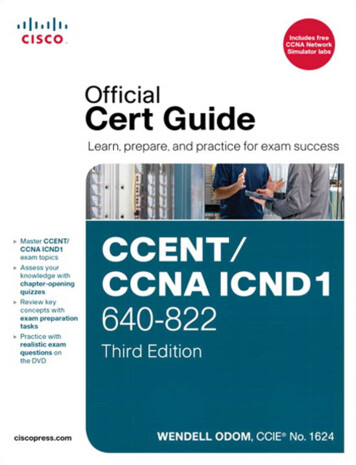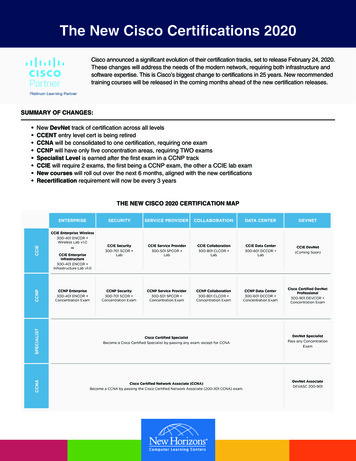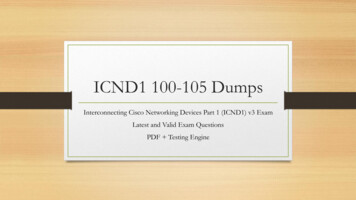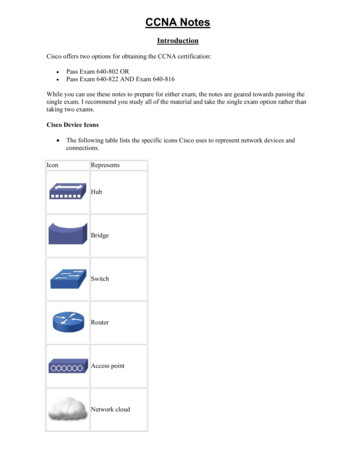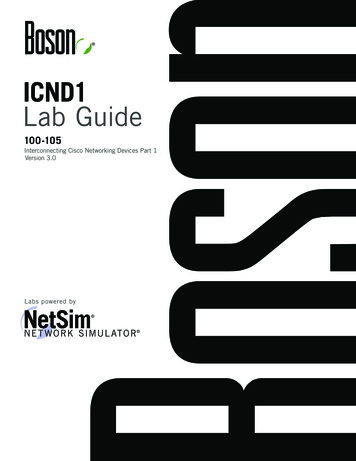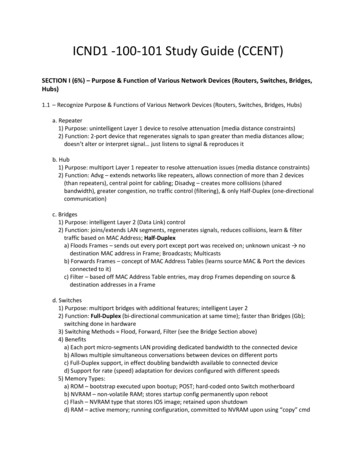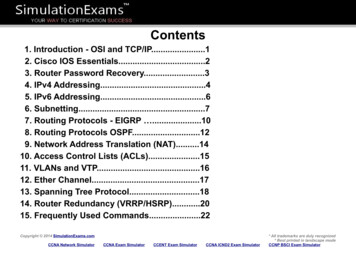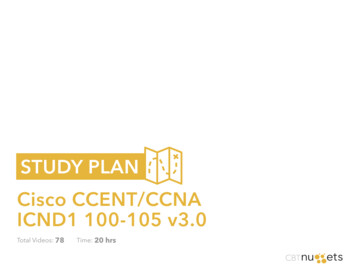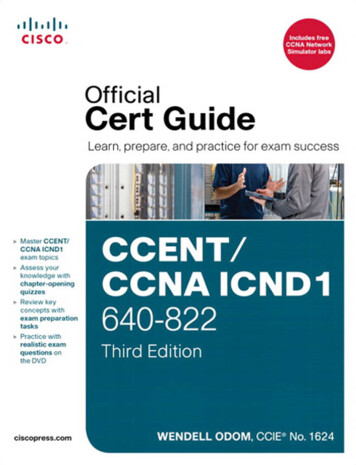
Transcription
CCENT/CCNA ICND1640-822 Official Cert GuideThird EditionWendell Odom, CCIE No. 1624Cisco Press800 East 96th StreetIndianapolis, IN 46240 USA
iiCCENT/CCNA ICND1 640-822 Official Cert GuideCCENT/CCNA ICND1 640-822 Official Cert Guide, Third EditionWendell OdomCCIE No. 1624Copyright 2012 Pearson Education, Inc.Published by:Cisco Press800 East 96th StreetIndianapolis, IN 46240 USAAll rights reserved. No part of this book may be reproduced or transmitted in any form or by any means, electronic ormechanical, including photocopying, recording, or by any information storage and retrieval system, without writtenpermission from the publisher, except for the inclusion of brief quotations in a review.Printed in the United States of AmericaFirst Printing October 2011Library of Congress Cataloging-in-Publication Data is on file.ISBN-13: 978-1-58720-425-8ISBN-10: 1-58720-425-8Warning and DisclaimerThis book is designed to provide information about the Cisco ICND1 (640-822) and CCNA (640-802) exams. Everyeffort has been made to make this book as complete and as accurate as possible, but no warranty or fitness is implied.The information is provided on an "as is" basis. The authors, Cisco Press, and Cisco Systems, Inc. shall have neitherliability nor responsibility to any person or entity with respect to any loss or damages arising from the informationcontained in this book or from the use of the discs or programs that may accompany it.The opinions expressed in this book belong to the author and are not necessarily those of Cisco Systems, Inc.Trademark AcknowledgmentsAll terms mentioned in this book that are known to be trademarks or service marks have been appropriately capitalized. Cisco Press or Cisco Systems, Inc., cannot attest to the accuracy of this information. Use of a term in this bookshould not be regarded as affecting the validity of any trademark or service mark.Corporate and Government SalesThe publisher offers excellent discounts on this book when ordered in quantity for bulk purchases or special sales,which may include electronic versions and/or custom covers and content particular to your business, training goals,marketing focus, and branding interests. For more information, please contact:U.S. Corporate and Government Sales1-800-382-3419 corpsales@pearsontechgroup.comFor sales outside the United States please contact:International Salesinternational@pearsoned.com
iiiFeedback InformationAt Cisco Press, our goal is to create in-depth technical books of the highest quality and value. Each book is craftedwith care and precision, undergoing rigorous development that involves the unique expertise of members from theprofessional technical community.Readers' feedback is a natural continuation of this process. If you have any comments regarding how we couldimprove the quality of this book, or otherwise alter it to better suit your needs, you can contact us through e-mail atfeedback@ciscopress.com. Please make sure to include the book title and ISBN in your message.We greatly appreciate your assistance.Publisher: Paul BogerManager Global Certification: Erik UllandersonAssociate Publisher: Dave DusthimerBusiness Operation Manager, Cisco Press: Anand SundaramExecutive Editor: Brett BartowTechnical Editors: Elan Beer, Teri Cook, Brian D’Andrea, Steve KalmanManaging Editor: Sandra SchroederDevelopment Editor: Andrew CuppProject Editor: Mandie FrankCopy Editor: Sheri CainEditorial Assistant: Vanessa EvansBook and Cover Designer: Gary AdairComposition: Mark ShirarIndexer: Larry SweazyProofreader: Sarah Kearns
ivCCENT/CCNA ICND1 640-822 Official Cert GuideAbout the AuthorWendell Odom, CCIE No. 1624, has been in the networking industry since 1981. He hasworked as a network engineer, consultant, systems engineer, instructor, and coursedeveloper; he currently works writing and creating certification tools. He is author of all theprevious editions of the Cisco Press CCNA Official Certification Guide series, as well as theCCNP ROUTE 642-902 Official Certification Guide, the CCIE Routing and SwitchingOfficial Certification Guide, Computer Networking First Step, the CCNA Video Mentor, IPNetworking (a college textbook), and he is the primary networking consultant for the CCNA640-802 Network Simulator from Pearson. He maintains study tools, links to his blogs, andother resources at www.certskills.com.
vAbout the Technical ReviewersElan Beer is a senior consultant and Cisco instructor specializing in multi-protocolnetwork design, network configuration, troubleshooting, and network maintenance. For thepast 20 years, Elan has trained thousands of industry experts in routing, switching, and datacenter architectures. Elan has been instrumental in large-scale professional service effortsdesigning and troubleshooting internetworks, performing network audits, and assistingclients with their short- and long-term design objectives. Elan has a global perspective ofnetwork architectures via his international clientele. Elan has used his expertise to designand troubleshoot networks in Malaysia, North America, Europe, Australia, Africa, China,and the Middle East. Most recently, Elan has been focused on data center design,configuration, and troubleshooting, as well as service provider technologies.In 1993, Elan was among the first to obtain Cisco’s Certified System Instructor (CCSI)certification, and in 1996, Elan was among the first to attain Cisco System’s highesttechnical certification: the Cisco Certified Internetworking Expert (CCIE). Since then, Elanhas been involved in numerous large-scale telecommunications networking projectsworldwide. Elan is known internationally as a leader in network architecture and trainingand has worked on many high-profile projects assisting companies with their goal ofimplementing leading-edge technologies in their corporate infrastructure.Teri Cook (CCSI, CCDP, CCNP, CCDA, CCNA, MCT, and MCSE 2000/2003: Security)has more than ten years of experience in the IT industry. She has worked with differenttypes of organizations in the private business and DoD sectors, providing senior-levelnetwork and security technical skills in the design and implementation of complexcomputing environments. Since obtaining her certifications, Teri has been committed tobringing quality IT training to IT professionals as an instructor. She is an outstandinginstructor who uses real-world experience to present complex networking technologies. Asan IT instructor, Teri has been teaching Cisco classes for more than five years.Brian D’Andrea (CCNA, CCDA, MCSE, A , and Net ) has 11 years of IT experience inboth medical and financial environments, where planning and supporting criticalnetworking technologies were his primary responsibilities. For the last five years, he hasdedicated himself to technical training. Brian spends most of his time with The TrainingCamp, an IT boot camp provider. Using his real-world experience and his ability to breakdifficult concepts into a language that students can understand, Brian has successfullytrained hundreds of students for both work and certification endeavors.Stephen Kalman is a data security trainer. He is the author or tech editor of more than 20 books,courses, and CBT titles. His most recent book is Web Security Field Guide, published by CiscoPress. In addition to those responsibilities, he runs a consulting company, Esquire MicroConsultants, which specializes in network security assessments and forensics. Mr. Kalmanholds SSCP, CISSP, ISSMP, CEH, CHFI, CCNA, CCSA (Checkpoint), A , Network , andSecurity certifications and is a member of the New York State Bar.
viCCENT/CCNA ICND1 640-822 Official Cert GuideDedicationFor Hannah Odom, the best daughter I could ask for. I love you, my girl!
viiAcknowledgmentsYou know, after writing books for 13 years now, I would think that there would besomething normal, something repetitive, and that each book would pretty much follow thesame process as others. It now seems that normal is actually abnormal, and that requireseveryone to think outside the box.More so than probably any other editions of these books, these books really are the resultof a team effort. The biggest news relates to all the extras Cisco Press added to the package.Thanks to Dave, Brett, Kourtnaye, Sandra, and all the folks at Cisco Press for going severalextra miles to make this “extra” edition happen, and with so many extra valuable pieces. Ithink the readers will appreciate the added value. Now, on to the specifics.First, my hat’s off to Drew Cupp. Wow. Between this book, the matching ICND2 OfficialCert Guide, and another title, Drew and I went from having no books to working on threetogether all at once. And they all fell into the same 5-month stretch from start to finish. Itmakes my head hurt thinking about it. Besides taking on extra work to get it done, Drew’sclarity of thought about how to get from here to there through the process, with so manydifferent print, DVD, and online elements, wow—no way this book gets done withoutDrew. Thanks, Drew: You da man!Brian, Teri, and Steve all did a great job technical editing the book. Besides helping findmistakes and keeping the book accurate, each tech editor brought a different perspective tothe process. I hope we can work together on future editions. And a special thanks to ElanBeer, the best tech editor in the business, for working on the new materials for this edition.You know, it’s great when the person you rely on most at work is consistently helpful andalways comes through, whether working on an opportunity or an issue. But, when thatperson actually works for a partner company, it’s all the more impressive. I am fortunateenough to have such an ally in Brett Bartow—thank you so much for walking this journeywith me.Mandie Frank gets the “hot potato” award for working as the project editor with this bookand with ICND2. The nature of this project plus the ICND2 book at practically the sametime can create some challenges. Mandie handled them all with grace and aplomb, and sheseamlessly managed the entire process with the rest of the production team. Thanks,Mandie, and the whole group! And thanks especially for the extra attention to the pagesreview.Thanks to Richard Bennett, who slaved on a short schedule on some figure improvementsthat I really wanted to include in this book and for his work on the question database. Dude,Robin Williams would be proud!
viiiCCENT/CCNA ICND1 640-822 Official Cert GuideA special thank you goes to you readers, who write in with suggestions, possible errors, andespecially those of you who post online at the Cisco Learning Network (CLN). Withoutquestion, the comments I receive directly and overhear by participating at CLN made thisedition a better book.Finally, thanks to my wife Kris for all her support with my writing efforts, her prayers, andunderstanding when the deadline didn’t quite match with our vacation plans this summer.(Yes, that’s twice in a row that when this book revved, we cancelled vacation—you’re adoll!) And thanks to Jesus Christ—all this effort is just striving after the wind without Him.
ixContents at a GlanceIntroductionPart I:xxviiNetworking Fundamentals3Chapter 1Introduction to Computer NetworkingChapter 2The TCP/IP and OSI Networking ModelsChapter 3Fundamentals of LANsChapter 4Fundamentals of WANsChapter 5Fundamentals of IPv4 Addressing and RoutingChapter 6Fundamentals of TCP/IP Transport, Applications, and SecurityPart II:LAN Switching77Chapter 8Operating Cisco LAN SwitchesChapter 9Ethernet Switch ConfigurationChapter 11 Wireless LANs173203237Chapter 10 Ethernet Switch Troubleshooting273305IPv4 Addressing and Subnetting335Chapter 12 Perspectives on IPv4 SubnettingChapter 13 Analyzing Classful IPv4 NetworksChapter 14 Converting Subnet MasksChapter 16 Designing Subnet Masks367397411Chapter 17 Analyzing Existing SubnetsChapter 18 Finding All Subnet IDs337383Chapter 15 Analyzing Existing Subnet MasksIPv4 Routing427459479Chapter 19 Operating Cisco Routers481Chapter 20 Routing Protocol Concepts and ConfigurationChapter 21 Troubleshooting IP RoutingPart V:99171Ethernet LAN Switching ConceptsPart IV:1747Chapter 7Part III:5Wide-Area NetworksChapter 22 WAN Concepts591593Chapter 23 WAN Configuration621553517135
xCCENT/CCNA ICND1 640-822 Official Cert GuidePart VI:Final Preparation645Chapter 24 Final PreparationPart VII:Appendixes647657Appendix A Answers to the “Do I Know This Already?” QuizzesAppendix B Numeric Reference Tables681Appendix C ICND1 Exam Updates: Version 1.0Glossary659689693Index 718Part VIII:DVD-OnlyAppendix D Practice for Chapter 13: Analyzing Classful IPv4 NetworksAppendix E Practice for Chapter 14: Converting Subnet MasksAppendix F Practice for Chapter 15: Analyzing Existing Subnet MasksAppendix G Practice for Chapter 16: Designing Subnet MasksAppendix H Practice for Chapter 17: Analyzing Existing SubnetsAppendix IPractice for Chapter 18: Finding All Subnet IDsAppendix J Additional ScenariosAppendix K Subnetting Video ReferenceAppendix L Memory TablesAppendix M Memory Tables Answer KeyAppendix N ICND1 Open-Ended Questions
xiContentsIntroductionPart I:xxviiNetworking FundamentalsChapter 13Introduction to Computer Networking5Perspectives on Networking 5The Flintstones Network: The First Computer Network? 8Chapter 2The TCP/IP and OSI Networking Models17“Do I Know This Already?” Quiz 17Foundation Topics 21TCP/IP Networking Model 21History Leading to TCP/IP 21Overview of the TCP/IP Networking Model 23TCP/IP Application Layer 24HTTP Overview 25HTTP Protocol Mechanisms 25TCP/IP Transport Layer 26TCP Error Recovery Basics 27Same Layer and Adjacent Layer Interactions 28TCP/IP Internet Layer 29Internet Protocol and the Postal Service 29Internet Protocol Addressing Basics 31IP Routing Basics 32TCP/IP Network Access Layer 33TCP/IP Model and Terminology 34Comparing the Two TCP/IP Models 34Data Encapsulation Terminology 35Names of TCP/IP Messages 36OSI Networking Model 37Comparing OSI and TCP/IP 37Describing Protocols by Referencing the OSI Layers 38OSI Layers and Their Functions 39OSI Layering Concepts and Benefits 41OSI Encapsulation Terminology 42Exam Preparation Tasks 43Review All the Key Topics 43Complete the Tables and Lists from Memory 43Definitions of Key Terms 43OSI Reference 44
xiiCCENT/CCNA ICND1 640-822 Official Cert GuideChapter 3Fundamentals of LANs47“Do I Know This Already?” Quiz 47Foundation Topics 51An Overview of Modern Ethernet LANs 51A Brief History of Ethernet 54The Original Ethernet Standards: 10BASE2 and 10BASE5 54Repeaters 56Building 10BASE-T Networks with Hubs 57Ethernet UTP Cabling 58UTP Cables and RJ-45 Connectors 58Transmitting Data Using Twisted Pairs 60UTP Cabling Pinouts for 10BASE-T and 100BASE-TX 611000BASE-T Cabling 64Improving Performance by Using Switches Instead of Hubs 64Increasing Available Bandwidth Using Switches 67Doubling Performance by Using Full-Duplex Ethernet 68Ethernet Layer 1 Summary 69Ethernet Data-Link Protocols 69Ethernet Addressing 70Ethernet Framing 71Identifying the Data Inside an Ethernet Frame 73Error Detection 74Exam Preparation Tasks 75Review All the Key Topics 75Complete the Tables and Lists from Memory 75Definitions of Key Terms 75Chapter 4Fundamentals of WANs77“Do I Know This Already?” Quiz 77Foundation Topics 80OSI Layer 1 for Point-to-Point WANs 80WAN Connections from the Customer Viewpoint 83WAN Cabling Standards 84Clock Rates, Synchronization, DCE, and DTE 86Building a WAN Link in a Lab 87Link Speeds Offered by Telcos 88OSI Layer 2 for Point-to-Point WANs 89HDLC 89Point-to-Point Protocol 91Point-to-Point WAN Summary 91Frame Relay and Packet-Switching Services 92The Scaling Benefits of Packet Switching 92Frame Relay Basics 93
xiiiExam Preparation Tasks 97Review All the Key Topics 97Complete the Tables and Lists from MemoryDefinitions of Key Terms 97Chapter 597Fundamentals of IPv4 Addressing and Routing99“Do I Know This Already?” Quiz 99Foundation Topics 104Overview of Network Layer Functions 104Routing (Forwarding) 105PC1’s Logic: Sending Data to a Nearby Router 106R1 and R2’s Logic: Routing Data Across the Network 106R3’s Logic: Delivering Data to the End Destination 106Network Layer Interaction with the Data Link Layer 107IP Packets and the IP Header 108Network Layer (Layer 3) Addressing 109Routing Protocols 110IP Addressing 111IP Addressing Definitions 111How IP Addresses Are Grouped 112Classes of Networks 113The Actual Class A, B, and C Network Numbers 115IP Subnetting 116IP Routing 120Host Routing 120Router Forwarding Decisions and the IP Routing Table 121IP Routing Protocols 124Network Layer Utilities 127Address Resolution Protocol and the Domain Name System 127DNS Name Resolution 128The ARP Process 128Address Assignment and DHCP 129ICMP Echo and the ping Command 131Exam Preparation Tasks 132Review All the Key Topics 132Complete the Tables and Lists from Memory 133Definitions of Key Terms 133Chapter 6Fundamentals of TCP/IP Transport, Applications, and Security“Do I Know This Already?” Quiz 135Foundation Topics 139TCP/IP Layer 4 Protocols: TCP and UDP 139Transmission Control Protocol 140Multiplexing Using TCP Port Numbers 141Popular TCP/IP Applications 144135
xivCCENT/CCNA ICND1 640-822 Official Cert GuideError Recovery (Reliability) 146Flow Control Using Windowing 147Connection Establishment and Termination 148Data Segmentation and Ordered Data Transfer 150User Datagram Protocol 151TCP/IP Applications 152QoS Needs and the Impact of TCP/IP Applications 152The World Wide Web, HTTP, and SSL 155Universal Resource Locators 156Finding the Web Server Using DNS 156Transferring Files with HTTP 158Network Security 159Perspectives on the Sources and Types of Threats 160Firewalls and the Cisco Adaptive Security Appliance (ASA)Anti-x 166Intrusion Detection and Prevention 166Virtual Private Networks (VPN) 167Exam Preparation Tasks 169Review All the Key Topics 169Complete the Tables and Lists from Memory 169Definitions of Key Terms 169Part II:LAN SwitchingChapter 7164171Ethernet LAN Switching Concepts173“Do I Know This Already?” Quiz 173Foundation Topics 177LAN Switching Concepts 177Historical Progression: Hubs, Bridges, and Switches 177Switching Logic 180The Forward Versus Filter Decision 181How Switches Learn MAC Addresses 183Flooding Frames 184Avoiding Loops Using Spanning Tree Protocol 185Internal Processing on Cisco Switches 186LAN Switching Summary 188LAN Design Considerations 189Collision Domains and Broadcast Domains 189Collision Domains 189Broadcast Domains 190The Impact of Collision and Broadcast Domains on LAN DesignVirtual LANs (VLAN) 193Campus LAN Design Terminology 194Ethernet LAN Media and Cable Lengths 197191
xvExam Preparation Tasks 200Review All the Key Topics 200Complete the Tables and Lists from MemoryDefinitions of Key Terms 201Chapter 8Operating Cisco LAN Switches200203“Do I Know This Already?” Quiz 203Foundation Topics 206Accessing the Cisco Catalyst 2960 Switch CLI 206Cisco Catalyst Switches and the 2960 Switch 207Switch Status from LEDs 208Accessing the Cisco IOS CLI 211CLI Access from the Console 212Accessing the CLI with Telnet and SSH 214Password Security for CLI Access 214User and Enable (Privileged) Modes 216CLI Help Features 217The debug and show Commands 219Configuring Cisco IOS Software 220Configuration Submodes and Contexts 221Storing Switch Configuration Files 223Copying and Erasing Configuration Files 226Initial Configuration (Setup Mode) 227Exam Preparation Tasks 232Review All the Key Topics 232Complete the Tables and Lists from Memory 232Definitions of Key Terms 232Command References 232Chapter 9Ethernet Switch Configuration237“Do I Know This Already?” Quiz 237Foundation Topics 241Configuration of Features in Common with Routers 241Securing the Switch CLI 241Configuring Simple Password Security 242Configuring Usernames and Secure Shell (SSH) 245Password Encryption 248The Two Enable Mode Passwords 250Console and vty Settings 251Banners 251History Buffer Commands 252The logging synchronous and exec-timeout CommandsLAN Switch Configuration and Operation 254Configuring the Switch IP Address 254Configuring Switch Interfaces 257253
xviCCENT/CCNA ICND1 640-822 Official Cert GuidePort Security 259VLAN Configuration 262Securing Unused Switch Interfaces 265Exam Preparation Tasks 267Review All the Key Topics 267Complete the Tables and Lists from Memory 267Definitions of Key Terms 268Command References 268Chapter 10 Ethernet Switch Troubleshooting273“Do I Know This Already?” Quiz 273Foundation Topics 277Perspectives on Network Verification and Troubleshooting 277Attacking Sim Questions 277Simlet Questions 278Multiple-Choice Questions 279Approaching Questions with an Organized Troubleshooting Process 279Isolating Problems at Layer 3, and Then at Layers 1 and 2 281Troubleshooting as Covered in This Book 282Verifying the Network Topology with Cisco Discovery Protocol 283Analyzing Layer 1 and 2 Interface Status 288Interface Status Codes and Reasons for Nonworking States 288Interface Speed and Duplex Issues 290Common Layer 1 Problems on Working Interfaces 293Analyzing the Layer 2 Forwarding Path with the MAC Address Table 295Analyzing the Forwarding Path 298Port Security and Filtering 299Exam Preparation Tasks 301Review All the Key Topics 301Complete the Tables and Lists from Memory 301Definitions of Key Terms 301Command References 301Chapter 11 Wireless LANs305“Do I Know This Already?” Quiz 305Foundation Topics 308Wireless LAN Concepts 308Comparisons with Ethernet LANs 309Wireless LAN Standards 310Modes of 802.11 Wireless LANs 311Wireless Transmissions (Layer 1) 313Wireless Encoding and Nonoverlapping DSSS ChannelsWireless Interference 317Coverage Area, Speed, and Capacity 317Media Access (Layer 2) 320315
xviiDeploying WLANs 321Wireless LAN Implementation Checklist 321Step 1: Verify the Existing Wired Network 322Step 2: Install and Configure the AP’s Wired and IP Details 323Step 3: Configure the AP’s WLAN Details 323Step 4: Install and Configure One Wireless Client 324Step 5: Verify That the WLAN Works from the Client 325Wireless LAN Security 326WLAN Security Issues 326The Progression of WLAN Security Standards 328Wired Equivalent Privacy (WEP) 328SSID Cloaking and MAC Filtering 329The Cisco Interim Solution Between WEP and 802.11i 330Wi-Fi Protected Access (WPA) 331IEEE 802.11i and WPA-2 331Exam Preparation Tasks 333Review All the Key Topics 333Complete the Tables and Lists from Memory 333Definitions of Key Terms 333Part III:IPv4 Addressing and Subnetting335Chapter 12 Perspectives on IPv4 Subnetting337“Do I Know This Already?” Quiz 337Foundation Topics 340Introduction to Subnetting 340Subnetting Defined Through a Simple Example 340Operational View Versus Design View of Subnetting 341Analyze Subnetting and Addressing Needs 342Rules About Which Hosts Are in Which Subnet 342Determining the Number of Subnets 344Determining the Number of Hosts per Subnet 345One Size Subnet Fits All—Or Not 346Defining the Size of a Subnet 346One Size Subnet Fits All 347Multiple Subnet Sizes (Variable Length Subnet Masks) 348This Book: One Size Subnet Fits All 349Make Design Choices 349Choose a Classful Network 350Public IP Networks 350Growth Exhausts the Public IP Address Space 351Private IP Networks 352Choosing an IP Network During the Design Phase 353Choose the Mask 354Classful IP Networks Before Subnetting 354Borrowing Host Bits to Create Subnet Bits 355
xviiiCCENT/CCNA ICND1 640-822 Official Cert GuideChoosing Enough Subnet and Host Bits 355Example Design: 172.16.0.0, 200 Subnets, 200 HostsMasks and Mask Formats 358Build a List of All Subnets 359Plan the Implementation 360Assigning Subnets to Different Locations 361Choose Static and Dynamic Ranges per Subnet 362Exam Preparation Tasks 364Review All the Key Topics 364Complete the Tables and Lists from Memory 364Definitions of Key Terms 364Chapter 13 Analyzing Classful IPv4 Networks357367“Do I Know This Already?” Quiz 367Foundation Topics 369Classful Network Concepts 369IPv4 Network Classes and Related Facts 369Actual Class A, B, and C Networks 370Address Formats 371Default Masks 372Number of Hosts per Network 373Deriving the Network ID and Related Numbers 373Unusual Network IDs and Network Broadcast Addresses 375Practice with Classful Networks 376Practice Deriving Key Facts Based on an IP Address 377Practice Remembering the Details of Address Classes 377Additional Practice 378Exam Preparation Tasks 379Review All the Key Topics 379Complete the Tables and Lists from Memory 379Definitions of Key Terms 379Practice 379Answers to Earlier Practice Problems 380Answers to Practice Problem 7 380Answers to Practice Problem 8 381Answers to Practice Problem 9 381Chapter 14 Converting Subnet Masks383“Do I Know This Already?” Quiz 383Foundation Topics 366Subnet Mask Conversion 386Three Mask Formats 386Converting Between Binary and Prefix Masks 387Converting Between Binary and DDN Masks 388Converting Between Prefix and DDN Masks 390
xixPractice Converting Subnet Masks 391Practice Problems for This Chapter 391Additional Practice 392Exam Preparation Tasks 393Review All the Key Topics 393Definitions of Key Terms 393Practice 393Answers to Earlier Practice Problems 394Chapter 15 Analyzing Existing Subnet Masks397“Do I Know This Already?” Quiz 397Foundation Topics 400Defining the Format of IPv4 Addresses 400Masks Divide the Subnet’s Addresses into Two Parts 401Masks and Class Divide Addresses into Three Parts 402Classless and Classful Addressing 403Calculations Based on the IPv4 Address Format 403Practice Analyzing Subnet Masks 405Practice Problems for This Chapter 406Additional Practice 407Exam Preparation Tasks 408Review All the Key Topics 408Definitions of Key Terms 408Practice 408Answers to Earlier Practice Problems 408Chapter 16 Designing Subnet Masks411“Do I Know This Already?” Quiz 411Foundation Topics 414Choosing the Mask(s) to Meet Requirements 414Review: Choosing the Minimum Number of Subnet and Host BitsNo Masks Meet Requirements 416One Mask Meets Requirements 417Multiple Masks Meet Requirements 418Finding All the Masks: Concepts 418Finding All the Masks: Math 420Choosing the Best Mask 421The Formal Process 421Practice Choosing Subnet Masks 422Practice Problems for This Chapter 422Additional Practice 423Exam Preparation Tasks 424Review All the Key Topics 424Definitions of Key Terms 424Practice 424Answers to Earlier Practice Problems 425414
xxCCENT/CCNA ICND1 640-822 Official Cert GuideChapter 17 Analyzing Existing Subnets427“Do I Know This Already?” Quiz 427Foundation Topics 430Defining a Subnet 430An Example with Network 172.16.0.0 and Four Subnets 430Subnet ID Concepts 432Subnet Broadcast Address 433Range of Usable Addresses 434Analyzing Existing Subnets: Binary 434Finding the Subnet ID: Binary 435Finding the Subnet Broadcast: Binary 437Binary Practice Problems 438Shortcut for the Binary Process 440Brief Note About Boolean Math 442Finding the Range of Addresses 442Analyzing Existing Subnets: Decimal 442Analysis with Easy Masks 443Predictability in the Interesting Octet 444Finding the Subnet ID: Difficult Masks 446Resident Subnet Example 1 446Resident Subnet Example 2 447Resident Subnet Practice Problems 448Finding the Subnet Broadcast Address: Difficult Masks 449Subnet Broadcast Example 1 449Subnet Broadcast Example 2 450Subnet Broadcast Address Practice Problems 451Practice Analyzing Existing Subnets 451A Choice: Memorize or Calculate 451Practice Problems for This Chapter 452Additional Practice 452Exam Preparation Tasks 453Review All the Key Topics 453Complete the Tables and Lists from Memory 453Definitions of Key Terms 453Practice 454Answers to Earlier Practice Problems 454Chapter 18 Finding All Subnet IDs459“Do I Know This Already?” Quiz 459Foundation Topics 462Finding All Subnet IDs 462First Subnet ID: The Zero Subnet 462Finding the Pattern Using the Magic Number 463A Formal Process with Less Than 8 Subnet Bits 464Example 1: Network 172.16.0.0, Mask 255.255.240.0 465Example 2: Network 192.168.1.0, Mask 255.255.255.224 467
xxiFinding All Subnets with Exactly 8 Subnet Bits 469Finding All Subnets with More Than 8 Subnet Bits 469Process with 9–16 Subnet Bits 470Process with 17 or More Subnet Bits 471Practice Finding All Subnet IDs 472Practice Problems for This Chapter 473Additional Practice 473Exam Preparation Tasks 474Review All the Key Topics 474Definitions of Key Terms 474Answers to Earlier Practice Problems 474Answer, Practice Problem 1 474Answer, Practice Problem 2 475Answer, Practice Problem 3 476Part IV:IPv4 Routing479Chapter 19 Operating Cisco Routers481“Do I Know This Already?” Quiz 481Foundation Topics 485Installing Cisco Routers 485Installing Enterprise Routers 485Cisco Integrated Services Routers 487Physical Installation 488Installing Internet Access Routers 489A SOHO Installation with a Separate Switch, Router, and Cable Modem 489A SOHO Installation with an Integrated Switch, Router, and DSL Modem 490Regarding the SOHO Devices Used in This Book 491Cisco Router IOS CLI 491Comparisons Between the Switch CLI and Router CLI 492Router Interfaces 493Interface Status Codes 495Router Interface IP Addresses 496Bandwidth and Clock Rate on Serial Interfaces 497Router Auxiliary (Aux) Port 499Initial Configuration (Setup Mode) 499Upgrading Cisco IOS Software and the Cisco IOS Software Boot Process 502Upgrading a Cisco IOS Software Image into Flash Memory 502The Cisco IOS Software Boot Sequence 505The Three Router Operating Systems 507The Configuration Register 507How a Router Chooses Which OS to Load 508The show version Command and Seeing the Configuration Register’sValue 511Exam Preparation Tasks 513Review All the Key Topics 513Complete the Tables and Lists from Memory 513
xxiiCCENT/CCNA ICND1 640-822 Official Cert GuideDefinitions of Key Terms 514Read Appendix J Scenario 2 514Command References 514Chapter 20 Routing Protocol Concepts and Configuration517“Do I Know This Already?” Quiz 517Foundation Topics 521Connected and Static Ro
holds SSCP, CISSP, ISSMP, CEH, CHFI, CCNA, CCSA (Checkpoint), A , Network , and Security certifications and is a member of the New York State Bar. vi CCENT/CCNA ICND1 640-822 Official Cert Guide Dedication For Hannah Odom, the best daughter I could ask for. I love you, my girl! vii
